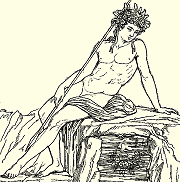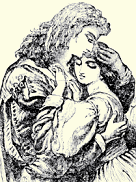|
性行為的發展 |
|
性行為的發展阶段:
青春期的性行為發展 |
|
性欲行為的發展:
歷史回顧 |
|
直到19世紀中葉,西方國家中產階級家庭的青少年發現他們自己處處既受到保護也受到壓制。他們一直都在忙於準備“真正的生活”:延長的學習(時間)和沒完沒了地為永遠更特殊的成人的工作做著各種準備,不再有(從前)被允許的性娛樂(sensual
distraction)了。從那時起,就像被定義的那樣,青少年們即使成長到青春期也是“不成熟的”。他們還被要求直到結婚之前保持性節欲,但是直到新郎積攢足夠的錢、並因此能夠“養活一個家庭”之前,婚姻通常是不可能的事情。
可是,與此同時,就像所有偉大的文明所記載和所公佈的那樣,受過教育的成年人仍舊清醒地意識到年輕人的性欲潛力。的確,在西方藝術和文學裏許多著名的戀人都是青少年:伊洛斯與普緒客(Eros
and Psyche)、皮拉摩斯與提斯柏(Pyramus
and Thisbe)、特洛伊羅斯與克雷西達(Troilus
and Cressida)、達佛涅斯與克洛伊(Daphnis
and Chloe)、弗魯瓦和布朗歇弗洛(Floire
and Blancheflor)、奧卡森與尼科萊特(Aucassin
and Nicolette)和羅密歐與茱麗葉(Romeo
and Juliet)。年輕的男女通常也被描寫成拒絕情欲的人:當海倫離開他的丈夫墨奈勞斯(Menelaos)並跟隨帕裏司(Paris)到特洛伊時,她只有12歲。當“許多少年和少女目睹了那喀索斯(Narcissus)的愛人”的時候,他當時也只有16歲。當宙斯(Zeus)成功使蓋尼米得(Ganymede)
成為“自己的意中人”的時候,蓋尼米得甚至更為年輕;當阿波羅(Apollo)和西風(Zephyrus)在為自己的地盤爭奪的時候,雅辛托斯(Hyacinthus)還是一位英俊少年;海勒斯(Hylas)也如此,當赫拉克勒斯(Hercules)把他從父母身邊誘拐走時,他還是少年。我們同樣在著名的歌劇裏會找到癡情少年的事例:在莫札特的《費加羅的婚禮》裏,癡情少年凱魯比諾(Cherubino)約15歲;在理查·施特勞斯的歌劇《玫瑰騎士》(Der
Rosenkavalier)裏,奧克達菲安(Octavian)是17歲,而且是年長的已婚女人的戀人[1]。
最後,要繼續列舉這種在“高度文明”和中產階級的道德之間的相互矛盾的現象讓人感到尷尬。尤其到了青年人反對他們父輩的(道德)“虛偽”之時,到了20世紀的下半葉,多數西方國家對青少年的性欲行為(erotic
behavior),採取了一種更為現實和更為寬容的態度。
|
|
 |
|
 |
 |
|
19世紀著名愛情故事舉例
(從左自右):伊洛斯與普緒客、那喀索斯、蓋尼米得、阿波羅與雅辛托斯和羅密歐與茱麗葉。圖片來源:FCIT,http://etc.usf.edu/clipart
19th- century illustrations of famous love stories
(from the left): Eros and Psyche, Narcissus, Ganymede, Apollo and Hyacinthus, Romeo and Juliet.
Source: FCIT,
http://etc.usf.edu/clipart
|
|
|
|
Development of Sexual Behavior |
|
Stages of Development: Adolescence |
|
Erotic Behavior: Historical Introduction |
|
By the middle of the 19th century, middle-class adolescents in Western countries found themselves both protected and pressured from all sides. They were kept busy preparing for “real life”: Extended study and an ever longer preparation for ever more specialized adult work no longer permitted sensual distractions. Young people now were, by definition, “immature”, even after puberty. They were also expected to remain sexually abstinent until marriage, but marriage was often impossible until the bridegroom had earned enough money and thus could “afford to support a family”.
At the same time, however, educated adults remained well aware of the erotic potential of the young as described and celebrated in all great civilizations. Indeed,
many of the famous lovers in Western art and literature are adolescents: Eros and Psyche, Pyramus and Thisbe, Troilus and Cressida, Daphnis and Chloe, Floire and Blancheflor, Aucassin and Nicolette, Romeo and Juliet. Young females and males were also often depicted as objects of passion: Helen was only 12 years old when she left her husband Menelaos and followed Paris to Troy. Narcissus was 16 when “many youths and maidens sought his love”. Ganymede was even younger when Zeus made him his favorite, Hyacinthus was an adolescent when Apollo and Zephyrus quarreled over his possession, and so was Hylas when Hercules abducted him from his parents. We also find examples of amorous teenagers in famous operas: The love-obsessed Cherubino in Mozart’s “Marriage of Figaro” is about 15 years old; Octavian in Richard Strauss’ “Rosenkavalier” is 17 and the lover of an older married woman.
Eventually, the contradiction between “high culture” and middle class morality became too embarrassing to continue.
Especially the young rebelled against the “hypocrisy” of their elders, and in the second half of the 20th century most Western countries adopted a more realistic and permissive attitude toward adolescent erotic behavior.
|